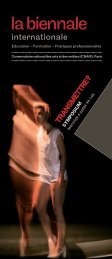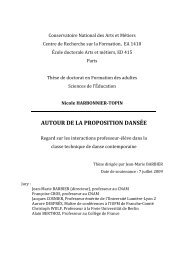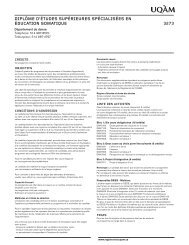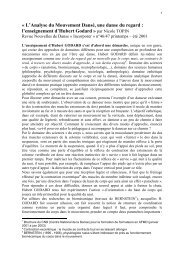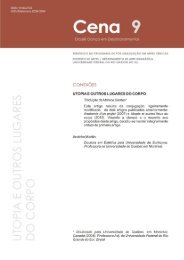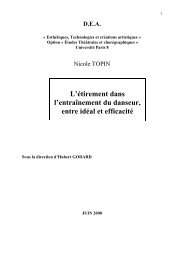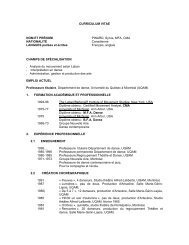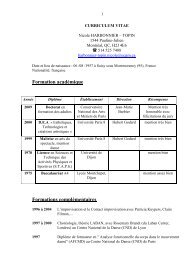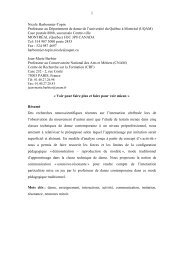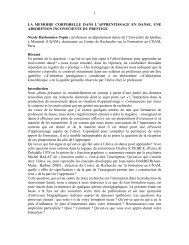Day 2 - Département de danse - UQAM
Day 2 - Département de danse - UQAM
Day 2 - Département de danse - UQAM
Create successful ePaper yourself
Turn your PDF publications into a flip-book with our unique Google optimized e-Paper software.
This statement, which I ma<strong>de</strong> during the <strong>de</strong>velopment of Nina Arsenault’s performance entitled 40 <strong>Day</strong>s and 40 Nights:<br />
Working Towards a Spiritual Experience, was inscribed by the artist on the walls of the installation. Arsenault inscribed this<br />
text, along with other fragments, automatic drawings and assorted visual ephemera on the walls of the Theatre Centre pop up<br />
space in Toronto’s Queen Street West area as part of the 2012 Summerworks Festival.<br />
As dramaturg for this event, I will offer a perspective on the process of creation as well as document some of the<br />
components of the installation.<br />
The work evolved over 40 days and nights, culminating in 10 days of public viewing from dusk to dawn (approximately 9<br />
pm until 5 am). While different showings varied in content, some parts of the installation were always fixed (such as her 90<br />
minute self-flagellation while nu<strong>de</strong>, riding an exercise bicycle, and her telling of the hour-long story of her recent facelift un<strong>de</strong>r<br />
local anesthesia, while in full make-up.) In the days and nights preceding the installation, Arsenault limited contact with the<br />
world, phenomenal and virtual, fasted, experimented with sleep <strong>de</strong>privation, light <strong>de</strong>privation.<br />
Did she achieve a spiritual experience? Did she discover, uncover or recover anything? These and other questions will<br />
form part of my paper which I propose falls into the category of “Bodies on the brink: extreme performance(s)”<br />
I have worked with Arsenault for twenty years, first as her mentor/professor during her transition, and then as dramaturg<br />
for her stage plays (The Silicone Diaries, I Was Barbie, and a new work currently in <strong>de</strong>velopment). I also edited a volume of<br />
essays and photographs about her work (TRANS(per)FORMING Nina Arsenault: An Unreasonable Body of Work, Intellect<br />
Books 2012). 40 <strong>Day</strong>s and 40 Nights represents a <strong>de</strong>parture from her theatrical work, moving her into the world of<br />
performance installation and as such is an important piece within her oeuvre.<br />
“Techniques for New Realist Performance, or, ‘What does ‘not-acting’ look like?’” Jenn<br />
Stephenson (Queen’s University)<br />
Theatre has not been aloof from the millennial fever for authenticity. New Realists among us <strong>de</strong>sire real food, expressed in the<br />
rise of locavorism (community gar<strong>de</strong>ns, backyard hens, nanobreweries); real clothes (vintage, handknits); real service (a<br />
human on the helpline, store greeters, customization); real experience (crowdsourcing, the do-it-yourself ethos, immersive<br />
tourism)—the list goes on (Shields, Boyle, Spretnak, Gilmore and Pine). Given the cultural capital assigned to the “real” in this<br />
particular moment, it is important not to naively accept the semblance of the real as being truly essentially real, rather it<br />
behooves us to examine how that “real” is constructed and specifically in the theatre why certain performance elements<br />
encourage reading as “real.”<br />
First, consi<strong>de</strong>ring what actors do, this study draws on a cognitive mo<strong>de</strong>l of acting which figures acting as “behaviour”<br />
resulting from the navigation of specific opportunities and restraints (Blair, Pinker). Using this framework, I assess the<br />
differences and commonalities in acting technique between presenting a fully fictional character and presenting an actual “self”<br />
(Kirby, Auslan<strong>de</strong>r). Second, this study turns to audience perception, examining the generic characteristics of “reality-based”<br />
performance to generate a mo<strong>de</strong>l for the dramaturgical and scenographic techniques which are calculated to promote our<br />
sense of the performer as “real.”<br />
For the <strong>de</strong>velopment of this mo<strong>de</strong>l, I draw on two recent reality-based autobiographical performances that present “notacting”:<br />
A Brimful of Asha (Ravi Jain and Asha Jain, Toronto 2011) and Winners and Losers (James Long and Marcus<br />
Youssef, Vancouver 2012). Both plays purport to be unmediated improvised conversations. One features a mother and son<br />
who affectionately disagree about the benefits of an arranged marriage. In the other, two best friends viciously dissect each<br />
other to <strong>de</strong>termine who is a winner and who is a loser. With this mo<strong>de</strong>l in hand, it will be possible to establish a pattern of<br />
connections to show how specific genre characteristics of reality-based performance work to support (or un<strong>de</strong>rmine) the<br />
thematic un<strong>de</strong>rstanding offered by each play.<br />
“‘Is this literature or truth?’: Trauma/Traumatic Reenactment in Michel Marc Bouchard’s The<br />
Orphan Muses.” Rebecca Halliday (York University)<br />
Several of Québécois playwright Michel Marc Bouchard’s scripts incorporate instances of metatheatre in which characters<br />
narrate and enact traumatic moments from a shared familial, historical or political past. Bouchard’s 1988 drama, Les Muses<br />
orphelines—translated into English by Linda Gaboriau as The Orphan Muses (1995)—is set in Lac Saint-Jean, Quebec, in<br />
1965, and <strong>de</strong>picts a tense reunion between four siblings two <strong>de</strong>ca<strong>de</strong>s after their mother’s <strong>de</strong>cision to abandon them for a<br />
Spanish soldier with whom she had begun an affair. This childhood trauma and its resultant secrets have impacted their<br />
familial and social relations since. Catherine, Martine, Luc and Isabelle Tanguay inhabit a “self-contained illusion outsi<strong>de</strong> the<br />
world of social praxis” (States 19) not simply as characters in a theatrical production but as actors in a constructed milieu.<br />
This paper illuminates the numerous metatheatrical layers Bouchard establishes and argues that the characters’<br />
habituated falsehoods, dramatic remembrances and mimetic enactments represent a distorted but nonetheless potent<br />
Freudian process of working through that both immerses the characters in and releases them from their fictions. First, I<br />
examine instances in which characters inhabit, in turn, the role of their mother, as well as the mother’s appearance as a<br />
“phantasmatic reproduction” (Hamacher 39) both through invocation and through material, semiotic traces. In particular, Luc’s<br />
imitation, in his mother’s clothes, is a problematic moment of transference in which he acts out his trauma through his mother’s<br />
form and projects his resentment onto the townspeople that judged her. Further, I <strong>de</strong>scribe sequences in which characters<br />
reenact the moment of their abandonment, building to a full, climactic, rehearsed performance insi<strong>de</strong> the house. Here,<br />
theatrical repetition functions both as resistance—producing in the characters a false “theatrical emotion” (Hurley 3)—and as a<br />
catalyst for the illusion’s rupture and their painful rebirth into the (nonetheless theatrical) ‘real’.<br />
14



